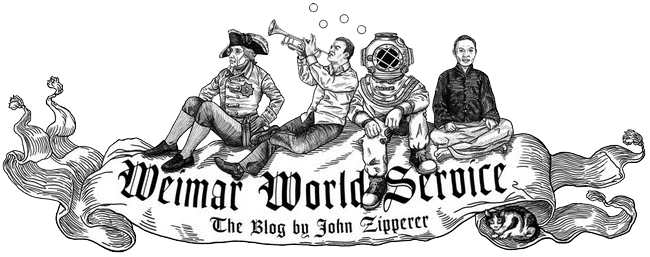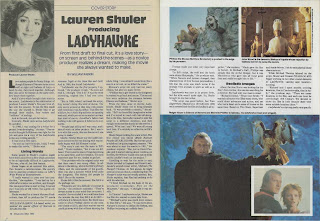On the corporate front, the company releases the latest (volume four) of its Starlog Scrapbook special, this time featuring Jane Fonda's Barbarella on the cover.
Starlog #94
76 pages (including covers)
Cover price: $2.95
One change that actually is a mixed-emotions situation was to make David Gerrold's long-running column appear every-other-month instead of monthly. I still don't know if that was the decision of Gerrold (who would, in a couple year's time, join the team that finally brings Star Trek back to weekly television, and likely had plenty of projects on his plate to keep himself busy) or if the publishers and editors actually thought they should reduce the presence of one of their defining voices in the magazine. Dunno. Nonetheless, they made the change, and at the same time they introduced a rather nifty guest column that would bring into the pages a number of writers -- some well known, others less so -- on a pretty wide variety of topics. They could have had both a Gerrold column and a guest column -- after all, at one point the magazine featured columns by Gerrold, Susan Sacket, Jonathan Eberhart, and David Houston, and it still found room for plenty of feature articles and the other departments. But they chose this path.
The rundown: In his From the Bridge column, publisher Kerry O'Quinn discusses the joys and the all-consuming passion of devoting yourself to projects that fascinate you; in the Communications section, readers share lots of ideas (sparked by what, I don't know) about George Lucas and his Star Wars creation, offer feedback (on Runaway, Starman, The Ewok Adventure, and The Terminator), defend England against David Gerrold, and more; in the Log Entries short-news section, Edward Gross (who, unless my mind is getting rusty, makes his first of many appearances in the magazine) chats with Gremlins writer Chris Columbus, David McDonnell previews an E.T. sequel in book form, Adam Pirani reports on the reopening of the James Bond film set destroyed by fire (see issue #87), David Hutchison previews new video casette releases, and more.
Mike Clark interviews V star June Chadwick; Fan Network debuts, packed with news and information; Adam Pirani interviews Robert Watts, producer of Indiana Jones and the Temple of Doom; Jim George and J. Cat McDowell interview Star Trek's Mr. Scott, James Doohan; the new Future Life section premieres with an article by Max Rottersman on the use of the space shuttle to retrieve satellites, plus short news reports on claims of the discovery of an extra-solar planet, NASA's 1985 launch schedule (including the classified mission on September 18 with a Department of Defense payload), and more; former editor of Famous Monsters of Filmland Forrest J. Ackerman is the first Other Voices guest columnist, and he announces a contest; William Rabkin interviews Ladyhawke producer Lauren Shuler (with a sidebar by Lee Goldberg chatting with Michelle Pfeiffer); Steve Swires interviews writer John Sayles (The Brother from Another Planet, Clan of the Cave Bear); Lee Goldberg previews the James Michener TV adaptation Space; in part six of his never-ending series, David Hutchison looks at staging the walker fighting in Star Wars: Return of the Jedi; Brian Lowry interviews William Katt, star of Baby and the late The Greatest American Hero; Lowry also interviews actor Yaphet Kotto, star of Alien and Live and Let Die, among others; Cary Bates interviews veteran film composer John Barry; Dennis Fischer examines the TV series Otherworld (which, I have to admit, I'd never heard of before I reviewed the issue for this Project, despite the fact that there frankly weren't very many genre programs around back in the mid-1980s); and Howard Zimmerman's Lastword explains how the magazine decides what to feature.
All in all, a great issue and a good magazine.
"[The Cannes Film Festival] was like going to Las Vegas, ... It's so trashy that it's funny. The festival is so transparent. There is no attempt made to disguise the fact that it's really about money. The foreign distributors just buy in bulk: 'Give me 500 hours of action, 500 hours of softcore and 200 hours of hardcore. I'll put my own titles on them.'"
–John Sayles, writer/director, interviewed by Steve Swires: "John Sayles: From Hoboken to Hollywood"To view previous Starlog issue descriptions, click on "Starlog Internet Archive Project" in the keywords below or visit the Starlog Project's permanent home.




No comments:
Post a Comment